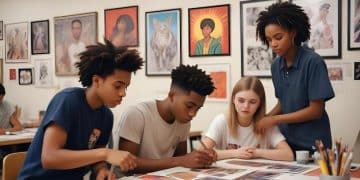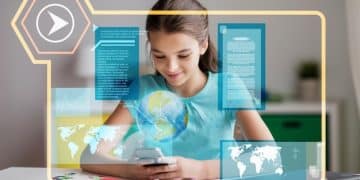Insider Knowledge: Combining Learning Styles for Max Retention

Achieving maximum knowledge retention hinges on a strategic blend of diverse learning styles, moving beyond singular approaches to tap into the brain’s multifaceted processing capabilities.
For centuries, the quest for optimal knowledge retention has captivated educators and learners alike. What if the secret to truly embedding information, making it stick for the long haul, isn’t about finding the “best” learning style, but rather about a sophisticated blend? This deep dive into Insider Knowledge: The Untapped Potential of Combining Learning Styles for Maximum Retention explores how a synergistic approach can unlock unparalleled cognitive benefits, transforming how we acquire and retain information.
Beyond the ‘One-Size-Fits-All’ Myth: The Foundation of Combined Learning
The traditional narrative often pigeonholes individuals into a single learning style: visual, auditory, kinesthetic, or reading/writing. While these categories offer a useful starting point for self-awareness, they often oversimplify the intricate nature of human cognition. The reality is far more nuanced, suggesting that our brains are inherently wired for dynamic interaction with information, not a static intake method.
Understanding this fundamental principle is the first step toward unlocking the true potential of combined learning. It means moving past the comfort zone of a preferred style and embracing a more versatile processing strategy. This shift in perspective is not just about adding more techniques; it’s about fostering cognitive agility and building more robust memory pathways. The more ways we interact with a piece of information, the more deeply it’s encoded in our long-term memory.
The Limitations of Singular Style Emphasis
Relying solely on one learning style can create blind spots and hinder a comprehensive understanding of complex subjects. For instance, a purely visual learner might struggle with abstract concepts presented verbally, while an auditory learner might miss crucial details in a silent diagram. This narrow focus restricts the brain’s natural ability to contextualize and integrate new data across different sensory modalities.
- Reduced Versatility: Limits adaptability to various teaching methods and information formats.
- Surface-Level Processing: May lead to memorization without deep comprehension.
- Incomplete Understanding: Overlooks nuances best conveyed through alternative sensory inputs.
By understanding these limitations, learners can begin to identify areas where diversifying their approach would be most beneficial. It’s about recognizing that every piece of information might have a “best fit” for retention, and that fit often involves multiple sensory and cognitive pathways.
Embracing Cognitive Flexibility
Cognitive flexibility, the ability to switch between different mental processes or adapt to new, changing, or unexpected situations, is paramount in today’s information-rich environment. When applied to learning, it means consciously engaging multiple cognitive functions simultaneously or sequentially. This isn’t just about using visual aids if you’re an auditory learner; it’s about actively mapping the sound to an image, then physically writing down its key points.
This active engagement stimulates different brain regions, creating a richer, more interconnected neural network for the information. Think of it like building a house with multiple entry points and strong, interconnected rooms, rather than a single, isolated structure. Each connection reinforces the others, making the overall knowledge structure more resilient and accessible.
Ultimately, the foundation of combined learning is built on the understanding that our brains are not passive recipients but active constructors of knowledge. By deliberately engaging multiple learning styles, we empower this constructive process, leading to retention that is both deep and lasting.
The Synergy of Sensory Inputs: How Combination Enhances Encoding
The human brain is a marvel of interconnectedness, constantly integrating information from various sensory channels. When we deliberately combine different learning styles, we leverage this inherent neural architecture, creating a powerful synergy that significantly enhances the encoding process. This isn’t just about “learning more”; it’s about “learning better,” making memories more robust and less susceptible to decay.
Consider the process of learning a new language. Merely listening to words (auditory) might help with pronunciation, but seeing the written form (visual) strengthens recognition. Speaking the words aloud and associating them with actions (kinesthetic) further cements them into long-term memory. Each sensory input provides a unique anchor, reinforcing the others and creating a multi-dimensional representation of the information in the brain.
The Power of Multisensory Engagement
Multisensory engagement refers to the simultaneous or sequential use of multiple senses during the learning process. This approach is rooted in neuroscience, which demonstrates that when different sensory pathways are activated concurrently, the brain forms stronger, more resilient memory traces. It’s akin to having multiple keys to unlock the same door, increasing the likelihood of successful retrieval.
- Enhanced Neural Connections: Activates a wider network of brain regions, forming more redundant pathways.
- Improved Recall Cues: Provides multiple retrieval cues, making it easier to access forgotten information.
- Deeper Processing: Requires more cognitive effort, leading to a more thorough understanding and encoding.
For example, when learning about the circulatory system, a student might visually examine a diagram, listen to a lecture explaining the process, read descriptions of the organs, and then physically draw or build a model. Each activity reinforces the information, building a layered understanding that is far more durable than relying on a single method.
From Short-Term to Long-Term Memory
The journey from short-term to long-term memory is a complex process involving encoding, consolidation, and retrieval. Combined learning styles play a crucial role in the encoding phase, which is the initial processing of information into a format that can be stored. By engaging multiple senses, we create richer, more elaborate encodings, making the information more distinctive and memorable.
When information is encoded in multiple ways—through visual, auditory, kinesthetic, and reading/writing channels—it creates multiple “hooks” for retrieval. If one hook fails, others are available. This redundancy is a key factor in transforming fleeting short-term memories into enduring long-term knowledge. It’s why studying a concept in different formats, such as watching a video, discussing it with peers, and then writing a summary, is significantly more effective than simply reading a textbook once.

Moreover, the active processing involved in switching between styles helps in the consolidation phase, where memories are stabilized and strengthened. This active manipulation of information helps the brain to integrate new knowledge with existing schemas, building a coherent and accessible knowledge base. The synergy of sensory inputs is not merely about accumulating facts; it’s about weaving a robust tapestry of understanding that stands the test of time.
Strategic Blending Techniques: Practical Applications for Enhanced Learning
Moving beyond the theoretical, the real power of combining learning styles lies in its practical application. Strategic blending isn’t about haphazardly throwing different techniques at a subject; it’s about thoughtfully integrating them to maximize their cumulative effect. This section explores actionable strategies that learners, educators, and trainers can employ to create more effective and enduring learning experiences.
The key is to identify the core components of the information to be learned and then match them with the most effective combination of sensory inputs. This requires a level of self-awareness and intentionality that transcends simply “doing what feels natural.” It’s about designing a learning pathway that actively recruits multiple cognitive strengths, leading to deeper engagement and superior retention.
The VARK Model as a Guide for Integration
While the VARK model (Visual, Auditory, Reading/Writing, Kinesthetic) is sometimes used to categorize individual preferences, it serves even better as a framework for *integrating* different approaches. Instead of identifying as “a visual learner,” consider how to incorporate visual elements, auditory cues, tactile experiences, and written summaries into your study routine.
- Visual + Auditory: Watching educational videos where concepts are explained both visually and verbally.
- Reading/Writing + Kinesthetic: Reading notes aloud while pacing, or illustrating concepts through drawing mind maps.
- Kinesthetic + Auditory: Explaining a concept to someone else while using gestures or building a physical model.
The beauty of the VARK model, when used for blending, is its simplicity in categorizing different input methods. It allows learners to systematically ensure they’re touching upon each major sensory gateway, reinforcing the information from various angles. This structured approach helps prevent over-reliance on a single method and encourages exploration of underutilized cognitive pathways.
Active Recall and Spaced Repetition Reinforcement
Combining learning styles is extraordinarily effective when paired with proven memory consolidation techniques like active recall and spaced repetition. Active recall involves retrieving information directly from memory rather than simply re-reading it, while spaced repetition involves reviewing material at increasing intervals.
Imagine reading “The War of the Worlds” (reading/writing), then listening to the famous radio broadcast (auditory), discussing the themes with a friend (auditory/kinesthetic explanation), and finally, mapping out the Martian invasion route on a physical map (visual/kinesthetic). Later, actively recall details by writing a summary from memory without looking at notes, then reviewing those details a few days later, then a week later, and so on. This multi-modal input, combined with consistent retrieval practice, dramatically enhances retention.
These strategies create a powerful feedback loop. The varied inputs from combined styles make the information more memorable during initial encoding, and active recall strengthens those diverse encodings by forcing the brain to retrieve them from different access points. Spaced repetition ensures that this multi-faceted memory trace is continually reinforced, preventing it from fading over time.
Ultimately, strategic blending isn’t about complicated educational theories; it’s about smart, intentional practice. By consciously integrating visual, auditory, reading/writing, and kinesthetic elements into our learning processes, and then reinforcing these via active recall and spaced repetition, we can transform our retention capabilities from good to exceptional.
Understanding Your Learning Preferences: A Foundation for Effective Blending
While the core message is about combining styles, understanding your inherent learning preferences is still a crucial first step. This self-awareness isn’t about pigeonholing yourself, but rather acknowledging your natural strengths and identifying areas where deliberate diversification might be necessary. Think of it as knowing your starting point on a journey towards more holistic learning.
Many individuals unknowingly gravitate towards certain methods because they feel more comfortable or have yielded past successes. However, comfort doesn’t always equate to optimal retention, especially for complex or multi-faceted information. A clear understanding of your preferences allows you to consciously integrate other styles, moving beyond default settings to a more strategic approach.
Self-Assessment and Reflection
The journey to effective blending begins with honest self-assessment. This isn’t about online quizzes providing definitive answers, but rather a reflective process that observes how you most effectively absorb and process information. Ask yourself:
- When learning new concepts, do you prefer diagrams and charts, or detailed explanations?
- Do you retain more from listening to podcasts or lectures, or from reading textbooks?
- Does physically doing something—like building a model or role-playing—help solidify your understanding?
Reflecting on past learning experiences, both successful and challenging ones, can provide invaluable insights. What study methods led to deep understanding? Which ones felt like rote memorization that quickly faded? These observations form the empirical basis for tailoring a multi-style approach that genuinely works for you.
Identifying Over-Reliance and Gaps
Once you’ve reflected on your preferences, the next step is to identify any areas of over-reliance or hidden gaps. For instance, a student who consistently achieves high grades by simply reading and re-reading notes (a common approach for reading/writing learners) might assume this is the ‘best’ way. However, if they struggle with applying that knowledge in practical scenarios or explaining it verbally, it signals a potential gap in kinesthetic or auditory processing.
Similarly, a kinesthetic learner who excels in hands-on tasks might neglect the foundational theoretical knowledge often conveyed through visual or textual means. Recognizing these imbalances is key. It allows you to target specific styles for conscious integration, ensuring that you’re not just reinforcing what you already do well, but also strengthening your weaker, yet potentially crucial, learning pathways.
Ultimately, understanding your learning preferences is not a destination, but a starting point for dynamic and flexible learning. It empowers you to build upon your strengths while intentionally developing a versatile toolkit of strategies, ensuring that you’re equipped to tackle any learning challenge, regardless of its format or complexity.
Overcoming Challenges: Common Obstacles and Solutions in Blended Learning
While the benefits of combining learning styles are substantial, implementing this approach isn’t always straightforward. Learners and educators often encounter various challenges, from ingrained habits to perceived lack of time or resources. Recognizing these obstacles is the first step toward devising effective solutions that pave the way for successful blended learning experiences.
The transition from a singular, preferred style to a multi-modal approach requires patience, self-discipline, and a willingness to step outside of one’s comfort zone. However, with strategic planning and a proactive mindset, these hurdles can be effectively navigated, ultimately leading to more robust learning outcomes.
Breaking Free from Single-Style Habits
One of the most significant challenges is breaking free from deeply ingrained habits. Years of relying on a particular learning style can make it feel unnatural or even inefficient to try new methods. For example, a visual learner might find lectures cumbersome, or an auditory learner might struggle with complex diagrams, leading to frustration and a return to their comfort zone.
- Start Small: Introduce one new style element at a time, gradually expanding your repertoire.
- Set Specific Goals: Dedicate a fixed amount of time (e.g., 15 minutes) to a less preferred style daily.
- Reflect on Progress: Keep a journal to note how new approaches feel and their perceived effectiveness.
The key here is persistent, incremental change. Celebrate small victories and acknowledge that discomfort is often a sign of growth. Over time, these new approaches will become more natural and integrated into your overall learning toolkit.
Addressing Time Constraints and Resource Limitations
Another common concern is the perception that combining styles is too time-consuming or requires extensive resources. “I don’t have time to create a mind map AND listen to a podcast AND write notes,” is a common lament. While true that some methods might require more effort, many blending techniques can be seamlessly integrated into existing routines.

Utilize digital tools that facilitate multi-modal learning, such as note-taking apps that allow for embedded audio or video. Transform commute time into listening time for lectures, or use short breaks to sketch diagrams related to a concept. The goal isn’t to add an overwhelming number of new tasks, but to optimize existing study time by varying the input methods.
For resource limitations, remember that effective blending doesn’t always require fancy technology. Simple methods like drawing on whiteboards, explaining concepts to a pet, or using household items as props for kinesthetic learning are often just as effective. Creativity and adaptability are your greatest assets when resources are scarce.
Ultimately, overcoming these challenges requires a shift in mindset. Instead of viewing blended learning as an arduous addition, frame it as a strategic optimization of your cognitive resources. By systematically addressing habits and creatively navigating constraints, learners can unlock the full potential of combined styles for maximum retention.
The Future of Learning: Embracing Holistic Approaches in Education and Training
As we advance into the 21st century, the landscape of education and professional training is undergoing a profound transformation. The simplistic view of learning styles is giving way to a more sophisticated understanding of cognitive processes. This paradigm shift emphasizes holistic, integrated approaches that move beyond singular methodologies, recognizing the multifaceted nature of human intelligence and memory. The future of learning unequivocally points towards an embrace of combined learning styles as the standard, not the exception.
The rapidly evolving demands of the modern world, characterized by information overload and constant change, necessitate learners who are adaptable, versatile, and capable of deep, contextual understanding. This demands a departure from passive information consumption and a move towards active, multi-sensory engagement that builds resilient and transferable knowledge bases.
Personalized Learning Pathways
One of the most exciting aspects of this shift is the potential for truly personalized learning pathways. While previously constrained by rigid curricula, technology now enables the creation of adaptive educational experiences that cater to individual needs while simultaneously encouraging the expansion of preferred learning styles. This means leveraging AI-powered platforms that can suggest multi-modal resources based on a learner’s progress and perceived strengths/weaknesses.
- Adaptive Content Delivery: Platforms analyzing engagement to recommend video, audio, or interactive exercises.
- Virtual Reality (VR) and Augmented Reality (AR): Immersive experiences combining visual, auditory, and kinesthetic inputs.
- Gamification: Learning through interactive games that stimulate multiple senses and reward active participation.
Personalization, in this context, is not about sticking to a single, preferred style. Instead, it’s about guiding learners through a strategic blend, ensuring they are exposed to information in diverse formats to optimize understanding and retention, pushing them beyond their comfort zones in a supportive and engaging manner.
Lifelong Learning and Skill Agility
The concept of “lifelong learning” is no longer a buzzword; it’s a fundamental necessity. In an era where skills can become obsolete quickly, the ability to rapidly acquire and integrate new knowledge is paramount. Combined learning styles foster this skill agility by training the brain to be more flexible and efficient in processing novel information, regardless of its initial presentation.
For professionals, this means being able to digest complex reports (reading/writing), participate effectively in remote team collaborations (auditory), analyze data visualizations (visual), and then implement solutions in a hands-on manner (kinesthetic). Organizations that integrate multi-modal training programs will cultivate a workforce that is not only knowledgeable but also highly adaptable and resilient in the face of continuous change.
The future of learning is dynamic, holistic, and deeply personalized. By consciously and strategically combining learning styles, we are not just optimizing knowledge retention; we are fostering a new generation of versatile, agile learners ready to tackle the complexities of tomorrow’s world. This isn’t just an insider’s tip; it’s a foundational shift in how we approach the very act of learning.
Building Your Integrated Learning Toolkit: Resources and Strategies
Cultivating an integrated learning approach requires more than just understanding the theory; it demands a practical toolkit of resources and strategies. This section provides actionable advice and points to types of tools that can empower learners to effectively combine styles, moving from abstract concept to tangible practice. Building this toolkit is an ongoing process of experimentation and refinement, tailored to individual needs and the specific subject matter.
The vast array of modern educational resources—both digital and analog—offers unprecedented opportunities for combining learning styles. The key is to be intentional in selecting and utilizing these tools, ensuring they contribute to a multi-modal and deeply engaging learning experience rather than simply adding to information overload.
Leveraging Digital Platforms and Apps
Technology has revolutionized the accessibility of diverse learning formats. Many digital platforms and applications are designed to support multiple sensory inputs, making it easier than ever to blend styles seamlessly into your study routine.
- Educational Video Platforms: YouTube, Khan Academy, and Coursera offer visual explanations with auditory narration.
- Podcasts and Audiobooks: Excellent for auditory learners, and can be paired with visual summaries or mind maps for note-taking.
- Interactive Simulations and Games: Provide kinesthetic engagement with visual and auditory feedback (e.g., pHET simulations, Duolingo for languages).
- Note-Taking Apps with Multimedia: OneNote, Evernote, and Notion allow you to embed text, images, audio recordings, and even sketches.
The strategic use of these tools can transform passive consumption into active, multi-sensory engagement. For instance, while watching an educational video (visual/auditory), pause to sketch key concepts (kinesthetic), and then write a summary in your own words (reading/writing). This layered approach significantly boosts retention.
Analog Techniques for Holistic Engagement
Despite the rise of digital tools, traditional analog methods remain incredibly powerful for combining learning styles. The physical act of writing, drawing, or manipulating objects offers unique cognitive benefits that digital interfaces often cannot replicate.
Consider using:
- Mind Mapping with Colors and Symbols: Combines visual organization with spatial kinesthetic memory.
- Flashcards: Can be visual (different colors/images), kinesthetic (flipping them), and used for active recall.
- Concept Mapping Using Post-it Notes: Allows for physical arrangement and rearrangement of ideas, fostering kinesthetic and visual understanding.
- Teaching Others: Explaining a concept aloud (auditory) while gesturing or drawing (kinesthetic/visual) is one of the most effective retention strategies.
These techniques encourage active processing and deep engagement with the material. The tactile experience of writing or moving objects can create stronger memory traces, making the information more accessible for retrieval. Integrating these hands-on approaches alongside digital resources creates a truly robust and versatile learning toolkit.
Ultimately, building your integrated learning toolkit is about continuously experimenting with different combinations of resources and strategies. No single tool or method is a panacea; rather, it’s the thoughtful and deliberate blending of diverse approaches that unlocks the true potential for maximum knowledge retention.
The Cognitive Benefits: Long-Term Retention and Transfer of Learning
The ultimate goal of any effective learning strategy is not just temporary understanding, but long-term retention and, crucially, the ability to transfer that knowledge to new contexts. The strategic combination of learning styles offers profound cognitive benefits that extend far beyond initial comprehension, leading to more durable memories and enhanced problem-solving capabilities. This deep impact is what truly differentiates a blended approach from more traditional, singular methods.
When information is encoded through multiple sensory and cognitive channels, it creates a richer, more interconnected network in the brain. This redundancy and complexity of neural pathways make the memory less fragile and more accessible over time. Imagine building a bridge with multiple sturdy supports rather than just one; it’s far more resilient to the forces of time and decay.
Enhanced Memory Consolidation
Memory consolidation is the process by which temporary, unstable memories are transformed into more stable, long-lasting forms. This process occurs primarily during sleep and periods of rest, but its effectiveness is heavily influenced by how the information was initially encoded. Combined learning styles significantly enhance this consolidation process.
By engaging multiple brain regions and forming diverse neural pathways during acquisition, the brain has more “material” to work with during consolidation. This leads to more robust memory traces that are less prone to interference or forgetting. For example, a concept learned through reading, then discussed, and finally practiced hands-on, provides the brain with multiple points of connection, making it easier to integrate into existing knowledge structures during sleep.
Improved Information Retrieval
One of the most frustrating aspects of learning is knowing you’ve “learned” something but being unable to recall it when needed. Combined learning styles address this directly by providing multiple retrieval cues. If one pathway to a memory is temporarily blocked, another avenue exists. This is akin to having multiple distinct routes to a destination; if one road is closed, you have alternatives.
For instance, if you’ve learned about a historical event by watching a documentary (visual/auditory), reading accounts (reading), and discussing it with peers (auditory/kinesthetic), you have several potential ways to retrieve that information. A visual cue from the documentary, a specific phrase from the discussion, or even the feeling of gesturing during the discussion can all trigger the memory, making recall more reliable and efficient.
Facilitating Transfer of Learning
Perhaps the most critical long-term benefit of combined learning styles is its profound impact on the transfer of learning. This refers to the ability to apply knowledge and skills acquired in one context to new and different situations. Traditional, rote learning often struggles with transfer because the knowledge is too rigidly tied to the specific acquisition method.
However, when concepts are understood through multiple modalities, they become more abstract, flexible, and decontextualized from the original learning situation. This allows the learner to recognize the underlying principles and apply them across varied scenarios. For example, understanding physics concepts through equations (reading), physical demonstrations (kinesthetic), and animations (visual) makes those concepts more adaptable to real-world problem-solving, from engineering to everyday observations.
In essence, the cognitive benefits of combining learning styles extend beyond mere remembering; they cultivate a deeper, more adaptable form of knowledge that empowers lifelong learning and effective application in an ever-changing world. This is the hallmark of true mastery and the ultimate promise of this integrated approach.
| Key Point | Brief Description |
|---|---|
| 🧠 Enhanced Retention | Combining styles creates multiple neural pathways, making memories stronger and more resistant to decay. |
| 🔄 Cognitive Flexibility | Develops adaptability in processing information, vital for complex subjects and real-world application. |
| 🛠️ Strategic Application | Practical techniques like VARK integration and multisensory engagement boost learning effectiveness. |
| 🚀 Future of Learning | Integrated and personalized approaches are shaping education, fostering lifelong skill agility and deeper understanding. |
Frequently Asked Questions
▼
The main learning styles typically categorized are Visual (learning by seeing), Auditory (learning by hearing), Reading/Writing (learning by reading and writing), and Kinesthetic (learning by doing or experiencing). While useful for preference identification, a blended approach across these styles is often more effective for deeper retention.
▼
Combining learning styles creates multiple neural pathways for information, making memories stronger and more accessible. When information is processed through various senses, it leads to richer encoding, enhanced consolidation, and more reliable retrieval, ultimately improving long-term retention compared to relying on a single method.
▼
You can identify your primary learning preference through self-reflection on past learning experiences: what study methods felt most natural and led to the best recall? Observe if you prefer diagrams, lectures, reading, or hands-on activities. Various online quizzes and self-assessments can also provide insight, though it’s important to remember they are guides, not definitive labels.
▼
Practical blending techniques include watching educational videos (visual/auditory), drawing mind maps while listening to a lecture (visual/auditory/kinesthetic), explaining concepts aloud to others (auditory/kinesthetic), and making physical flashcards (visual/kinesthetic). Integrating active recall and spaced repetition with these multi-modal inputs further enhances their effectiveness.
▼
Yes, combining learning styles significantly enhances the transfer of learning. By understanding concepts through diverse modalities, the knowledge becomes more flexible and less tied to a specific context. This allows learners to apply what they’ve learned in one situation to new, unfamiliar problems, fostering greater adaptability and problem-solving abilities.
Conclusion
The journey to mastering knowledge retention is not a sprint, but a marathon, and its secret lies not in isolating learning styles, but in their powerful synergy. As we’ve explored, moving beyond the confines of a single preferred method unlocks unparalleled cognitive advantages, enhancing memory encoding, consolidation, and retrieval. By strategically blending visual, auditory, reading/writing, and kinesthetic approaches, learners can build more resilient, interconnected neural networks, transforming fleeting information into enduring understanding. This holistic approach not only cultivates deeper learning but also fosters the cognitive agility essential for navigating an ever-evolving world. Embracing these insider strategies is the key to unlocking your full learning potential and achieving truly maximized retention.





